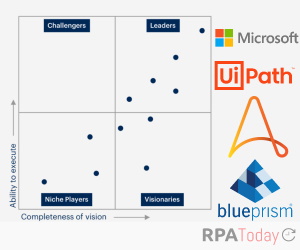
For the third year in a row, Gartner produced a “Magic Quadrant” for RPA—a sign that employing automation technology has entered the mainstream of business thinking. After consolidation brought large enterprise software companies to the sector last year (and another one this week), one of the biggest names in the industry made a significant move in this year’s Magic Quadrant—Microsoft joins UiPath, Automation Anywhere and Blue Prism in the “leaders” category.
“The RPA market is growing rapidly, as incumbent vendors jockey for position and evolve their offerings. Through 2024, we expect this market to mature and consolidate,” the authors wrote in the Gartner report. “At present, it is still highly fragmented, as vendors in adjacent markets are beginning to offer RPA capabilities. Gartner finds that the 10 largest RPA vendors account for more than 80 percent of the market (up from 70 percent in 2020), and that the three largest vendors account for 52 percent.”
Magic Quadrants use a proprietary analysis to place industry vendors in a graph that plots “ability to execute” on one axis and “completeness of vision on the other.” Companies that exhibit a high degree of both (those in the upper right “quadrant”) are identified by Gartner as “leaders” in the space.
“Each year, vendors raise the bar in terms of their viability, relevance, growth, revenue, innovation and vision for RPA software offerings,” the report said.
In addition to the “leaders,” the Stamford. Conn.-based consultancy included 14 other RPA providers in its analysis: Appian, Cyclone Robotics, EdgeVerve Systems, IBM, Kryon, Laiye, NICE, Nintex, NTT, Pegasystems, Samsung SDS, SAP, Servicetrace and WorkFusion.

